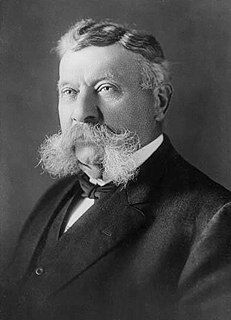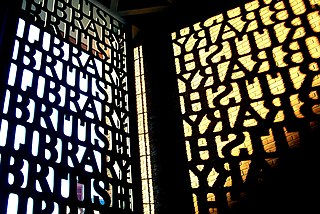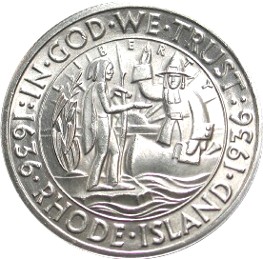
Arthur Eric Rowton Gill was an English sculptor, typeface designer, and printmaker, who was associated with the Arts and Crafts movement. His religious views and subject matter contrast with his sexual behaviour, including his erotic art, and his extramarital affairs and sexual abuse of his daughters, sisters, and dog.
The year 1984 in architecture involved some significant architectural events and new buildings.

Stone carving is an activity where pieces of rough natural stone are shaped by the controlled removal of stone. Owing to the permanence of the material, stone work has survived which was created during our prehistory or past time.
Cephas Thompson was a successful, largely self-taught, early nineteenth-century itinerant portrait painter in the United States. He was born, died, and lived most of his life in Middleborough, Massachusetts, but traveled extensively down the Atlantic coast and lived far from home for months at a time while pursuing his career as a portraitist.

The Guild of St Joseph and St Dominic was a Roman Catholic community of artists and craftspeople founded in 1920 in Ditchling, East Sussex, England. It was part of the Arts and Crafts movement and its legacy led to the creation of Ditchling Museum of Art + Craft.

Charles I. D. Looff was a German master carver and builder of hand-carved carousels and amusement rides, who immigrated to the United States of America in 1870. Looff built the first carousel at Coney Island in 1876. During his lifetime, he built over 40 carousels, several amusements parks, numerous roller coasters and Ferris wheels, and built California's famous Santa Monica Pier. He became famous for creating the unique Coney Island style of carousel carving.

David Guy Barnabas Kindersley MBE was a British stone letter-carver and typeface designer, and the founder of the Kindersley Workshop. His carved plaques and inscriptions in stone and slate can be seen on many churches and public buildings in the United Kingdom. Kindersley was a designer of the Octavian font for Monotype Imaging in 1961, and he and his third wife Lida Lopes Cardozo designed the main gates for the British Library.

Judith Dupré is a writer, structural historian, and public speaker. She is the New York Times bestselling author of several works of narrative nonfiction on art, design, and architecture. She has been described as “a scholar with a novelist’s eye for detail and a journalist’s easy style.”

The John Stevens Shop, founded in 1705, is a stone carving business on Thames Street in Newport, Rhode Island, that is one of the oldest continuously operating businesses in the United States.
John Everett Benson, known as Fud, is an American calligrapher, stonecarver and typeface designer who has created inscriptions for monuments including the John F. Kennedy memorial at Arlington National Cemetery, the National Gallery of Art, the Franklin Delano Roosevelt Memorial, and the Vietnam Memorial in Washington, DC.

Founded in 1854 as the Lambeth School of Art, the City and Guilds of London Art School is a small specialist art college located in central London, England. Originally founded as a government art school, it is now an independent, not-for-profit charity, and is one of the country's longest established art schools. It offers courses ranging from art and design Foundation, through to BA (Hons) undergraduate degrees and MA postgraduate courses in fine art and conservation. In addition, it offers the only undergraduate and postgraduate degrees in Britain in stone and wood carving: historic architectural stone and ornamental woodcarving and gilding.
Richard Mead Atwater Benson was an American photographer, printer, and educator who used photographic processing techniques of the past and present.
John Hegnauer is an American stone carver.

Letter cutting is a form of inscriptional architectural lettering closely related to monumental masonry and stone carving, often practiced by artists, sculptors, and typeface designers. Rather than traditional stone carving, where images and symbols are the dominant features, in letter cutting it is the beauty of the stone carver's calligraphy that is the focus. Notable practitioners include:

Edward Maene was a Belgian-American architectural sculptor, woodcarver and cabinetmaker.

The Rhode Island Tercentenary half dollar is a commemorative fifty-cent piece struck by the United States Bureau of the Mint in 1936. The coin was designed by John Howard Benson and Arthur Graham Carey. Its obverse depicts Roger Williams, founder of the Colony of Rhode Island and Providence Plantations. It was intended to honor the 300th anniversary of Providence, Rhode Island, although it bears no mention of the city.
John Howard Benson was an American calligrapher, stonecarver, incised letter designer, author, and educator.
Ermelindo Eduardo Ardolino, known as Edward Ardolino was an Italian-born American stone carver and architectural sculptor of the early twentieth century. He was the most prominent member of the Ardolino family of stone carvers. He worked with leading architects and sculptors, including architect Bertram Grosvenor Goodhue and sculptor Lee Lawrie. Ardolino participated in at least nine Goodhue-Lawrie collaborations including the Los Angeles Public Library and the Nebraska State Capitol. His carvings adorn a significant number of important public and private buildings and monuments, including four buildings in the Federal Triangle of Washington, D.C.

Lida Lopes Cardozo Kindersley is a letter-cutter, typeface designer, author and publisher and runs the Cardozo Kindersley Workshop in Cambridge. She is considered the foremost letter-cutter currently working in the United Kingdom and is "dedicated to the increase of good lettering in the world". Her work in slate, stone and other media includes carved memorials, plaques, inscriptions and sundials which can be seen at many public locations in the United Kingdom and beyond. Her works include the ledger stone for the grave of William Blake at Bunhill Fields. With her first husband David Kindersley she also designed the main gates for the British Library.












